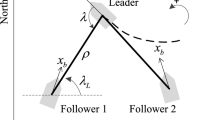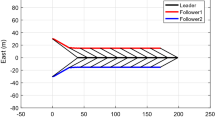Abstract
This note focuses on the leader–follower formation control problem of underactuated surface vehicles (USVs) with the unknown environmental disturbance. Especially, due to the ocean environmental disturbance, the vehicle’s desired-heading angle is altered violently. To address the constraint, a reduced-order extended state observer (ESO) is introduced. The sideslip angle of the vehicle is estimated online to amend the reference heading angle by virtue of the proposed observer. Furthermore, a novel adaptive formation control algorithm is presented to stabilize the dynamic error system. For the merits of the radial basis function neural networks (RBF NNs) and the minimal learning parameter (MLP) techniques, only two adaptive parameters require to be updated online to compensate for the perturbation from the model uncertainty and the environmental disturbance. Based on the proposed controller, it is illustrated that the desired formation pattern can be maintained without the effect of the sideslip angle. Meanwhile, all signals in the closed-loop system are proved to be with the semi-global uniformly ultimately bounded (SGUUB) stability. Finally, numerical simulations are conducted to demonstrate the effectiveness of the proposed algorithm.











Similar content being viewed by others
References
Chen YQ, Wang Z (2005) Formation control: a review and a new consideration. In: Proceedings of the 2005 IEEE/RSJ international conference on intelligent robots and systems, Edmonton, Canada, pp 3181–3186
Breivik M, Hovstein VE, Fossen TI (2008) Ship formation control: a guided leader-follower approach. Ifac Proc Vol 41(2):16008–16014
Beard RW, Lawton J, Hadaegh FY (2001) A coordination architecture for spacecraft formation control. IEEE Trans Control Syst Technol 9(6):777–790
Avanzini P, Royer E, Thuilot B (2013) Using monocular visual slam to manually convoy a fleet of automatic urban vehicles. In: Proceedings of the IEEE international conference on robotics and automation, Karlsruhe, Germany, pp 3219–3224
Fu M, Jiao J, Liu J, Wang Y (2013) Coordinated formation control of nonlinear marine vessels under directed communication topology. In: MTS/IEEE OCEANS, Bergen, Norway, pp 1–7
Xiang X, Yu C, Lapierre L, Zhang J, Zhang Q (2017) Survey on fuzzy-logic-based guidance and control of marine surface vehicles and underwater vehicles. Int J Fuzzy Syst 20(1):1–15
Xiao H, Li Z, Chen C (2016) Formation control of leader-cfollower mobile robots’ systems using model predictive control based on neural-dynamic optimization. IEEE Trans Ind Electron 63(9):5752–5762
Lewis MA, Tan KH (1997) High precision formation control of mobile robots using virtual structures. Auton Robots 4(4):387–403
Balch T, Arkin RC (1998) Behavior-based formation control for multirobot teams. IEEE Trans Robot Autom 14(6):926–939
Xiang X, Liu C, Su H, Zhang Q (2017) On decentralized adaptive full-order sliding mode control of multiple uavs. ISA Trans 71(2):196–205
Borhaug E, Pavlov A, Pettersen KY (2006) Cross-track formation control of underactuated surface vessels. In: Proceedings of the 45th IEEE conference on decision and control, San Diego, CA, USA, pp 5955–5961
Fahimi F (2007) Sliding-mode formation control for underactuated surface vessels. IEEE Trans Robot 23(3):617–622
Ianagui A, Filho AQ, Tannuri EA (2016) Experimental evaluation of sliding mode cooperative-controlled dp vessels. IFAC-PapersOnLine 49(23):245–250
Panagou D, Kyriakopoulos KJ (2013) Cooperative formation control of underactuated marine vehicles for target surveillance under sensing and communication constraints. In: Proceedings of the IEEE international conference on robotics and automation, Karlsruhe, Germany, pp 1871–1876
Peng Z, Wang D, Wang J (2016) Cooperative dynamic positioning of multiple marine offshore vessels: a modular design. IEEE/ASME Trans Mechatron 21(3):1210–1221
Filho AQ, Tannuri EA (2017) Cooperative consensus control applied to multi-vessel dp operations. Ocean Eng 142(sep.15):388–410
Fossen TI, Pettersen KY, Galeazzi R (2015) Line-of-sight path following for dubins paths with adaptive sideslip compensation of drift forces. IEEE Trans Control Syst Technol 23(2):820–827
Lekkas AM, Fossen TI (2014) Integral los path following for curved paths based on a monotone cubic hermite spline parametrization. IEEE Trans Control Syst Technol 22(6):2287–2301
Xu B, Shi Z, Yang C (2015) Composite fuzzy control of a class of uncertain nonlinear systems with disturbance observer. Nonlinear Dyn 80(1–2):341–351
Hu X, Du J, Xu D, Wu Y (2015) Robust nonlinear control for dynamic positioning system of ships based on disturbance observer. In: Proceedings of the world congress on intelligent control and automation (WCICA), Shenyang, China, pp 4554–4559
Miklosovic R, Radke A, Gao Z (2006) Discrete implementation and generalization of the extended state observer. In: American control conference, Minneapolis, MN, USA, pp 9047–9055
Le VA, Le HX, Nguyen L (2019) An efficient adaptive hierarchical sliding mode control strategy using neural networks for 3d overhead cranes. Int J Autom Comput 16:614–627
Xu B (2017) Disturbance observer-based dynamic surface control of transport aircraft with continuous heavy cargo airdrop. IEEE Trans Syst Man Cybern Syst 47(1):161–170
Sorensen AJ (2012) Marine control systems: propulsion and motion control of ships and ocean structures. Norwegian University of Science and Technology (Lecture Notes)
Qiao L, Zhang W (2017) Adaptive nonsingular integral terminal sliding mode tracking control for autonomous underwater vehicles. IET Control Theory Appl 11(8):1293–1306
Hu C, Wang R, Yan F, Chen N (2016) Robust composite nonlinear feedback path-following control for underactuated surface vessels with desired-heading amendment. IEEE Trans Ind Electron 63(10):6386–6394
Li J, Lee PM, Jun B, Lim Y (2008) Point-to-point navigation of underactuated ships. Automatica 44(12):3201–3205
Zhang G, Yao M, Xu J, Zhang W (2020) Robust neural event-triggered control for dynamic positioning ships with actuator faults. Ocean Eng 207:107292
Zhang G, Chu S, Jin X, Zhang W (2020) Composite neural learning fault-tolerant control for underactuated vehicles with event-triggered input. IEEE Trans Cybern. https://doi.org/10.1109/TCYB.2020.3005800
Liu L, Wang D, Peng Z (2017) Eso-based line-of-sight guidance law for path following of underactuated marine surface vehicles with exact sideslip compensation. IEEE J Ocean Eng 42(2):477–487
Fredriksen E, Pettersen KY (2006) Global exponential way-point maneuvering of ships: theory and experiments. Automatica 42(4):677–687
Lu Y, Zhang G, Sun Z, Zhang W (2018) Robust adaptive formation control of underactuated autonomous surface vessels based on mlp and dob. Nonlinear Dyn 94(1):503–519
Li Y, Li Y, Tong S (2013) Adaptive fuzzy decentralized output feedback control for stochastic nonlinear large-scale systems. Int J Robust Nonlinear Control 23(4):381–399
Skjetne R, Fossen TI, Kokotovi PV (2005) Adaptive maneuvering, with experiments, for a model ship in a marine control laboratory. Automatica 41(2):289–298
Fossen TI (2011) Handbook of marine craft hydrodynamics and motion control. Wiley, New York
Zhang G, Cai Y, Zhang W (2017) Robust neural control for dynamic positioning ships with the optimum-seeking guidance. IEEE Trans Syst Man Cybern Syst 47(7):1500–1509
Acknowledgements
This research is partially supported by the National Natural Science Foundation of China (No. 51909018), the Science and Technology Innovation Foundation of Dalian City (No.2019J12GX026), the Natural Science Foundation of Liaoning Province (No. 20170520189, 20180520039), and the Fundamental Research Funds for the Central Universities of China (3132020124). The authors would like to thank anonymous reviewers for their valuable comments to improve the quality of this note.
Author information
Authors and Affiliations
Corresponding author
Additional information
Publisher's Note
Springer Nature remains neutral with regard to jurisdictional claims in published maps and institutional affiliations.
About this article
Cite this article
Zhang, G., Yu, W., Zhang, W. et al. Robust adaptive formation control of underactuated surface vehicles with the desired-heading amendment . J Mar Sci Technol 27, 138–150 (2022). https://doi.org/10.1007/s00773-021-00820-2
Received:
Accepted:
Published:
Issue Date:
DOI: https://doi.org/10.1007/s00773-021-00820-2




